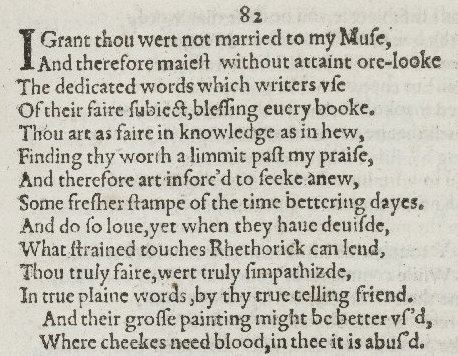I grant thou wert not married to my Muse,And therefore mayst without attaint o’erlookThe dedicated words which writers useOf their fair subject, blessing every book.Thou art as fair in knowledge as in hue,Finding thy worth a limit past my praise;And therefore art enforce’d to seek anewSome fresher stamp of the time-bettering days,And do so, love; yet when they have devis’dWhat strained touches rhetoric can lend,Thou truly fair wert truly sympathiz’dIn true plain words by thy true-telling friend;And their gross painting might be better us’dWhere cheeks need blood; in thee it is abus’d. 481214 | ||
 | ||
Q1Q2Q3C I grant thou wert not married to my Muse,And therefore mayst without attaint o’erlookThe dedicated words which writers useOf their fair subject, blessing every book.Thou art as fair in knowledge as in hue,Finding thy worth a limit past my praise;And therefore art enforce’d to seek anewSome fresher stamp of the time-bettering days,And do so, love; yet when they have devis’dWhat strained touches rhetoric can lend,Thou truly fair wert truly sympathiz’dIn true plain words by thy true-telling friend;And their gross painting might be better us’dWhere cheeks need blood; in thee it is abus’d. | ||
Sonnet 82 is one of 154 sonnets written by the English playwright and poet William Shakespeare. It is a member of the Fair Youth sequence, in which the poet expresses his love towards a young man, and the fifth sonnet of the Rival Poet subsequence.
Contents
Synopsis
Not being married to the poet's muse, the youth can honourably respond to other poets' muses without being accused of infidelity. But the youth shouldn't be too attracted to flashy and unrealistic rhetoric. The poet's own simple truthfulness more accurately represents the youth's beauty. Other poets only need to use artificial rhetoric to enhance anaemic figures.
Structure
Sonnet 82 is an English or Shakespearean sonnet. The English sonnet has three quatrains, followed by a final rhyming couplet. It follows the typical rhyme scheme of the form, abab cdcd efef gg and is composed in iambic pentameter, a type of poetic metre based on five pairs of metrically weak/strong syllabic positions. The 2nd line exemplifies a regular iambic pentameter:
× / × / × / × / × / And therefore mayst without attaint o'erlook (82.2)/ = ictus, a metrically strong syllabic position. × = nonictus.The sonnet exhibits several metrical variations, some of which are only potential. The following lines may be read with metrical regularity, but also admit of a rightward movement of the first ictus in line 4 (resulting in a four-position figure, × × / /, sometimes referred to as a minor ionic); and an initial reversal in line 5:
An unambiguous reversal and minor ionic may be found in lines 6 and 8, respectively.
The meter demands line 10's "strainèd" to be pronounced with 2 syllables.
